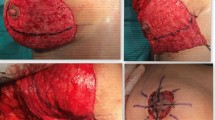Abstract
Background
Macromastia frequently affects females and can be upsetting. The main objective of any reduction procedure is to reduce the hypertrophic breast while maintaining a healthy nipple-areola complex, making reduction mammoplasty one of the most often done aesthetic procedures. To accomplish this, the skin envelope must be appropriately re-draped in order to achieve projected elevated, symmetrical breasts, scarcely perceptible scars, and lasting results.
Methods
Twenty-five patients who were candidates for wise-pattern reduction mammoplasty were included in the study. Two techniques of skin re-draping and closure were assessed; for each patient, both breasts were closed in two directions of closure either areola first closure (traditional technique) versus areola last (retrograde closure). Comparison between the differences in the intraoperative length of the wound was compared.
Results
The direction of skin closure starting from the periphery and ending with areola closure as a last step has a statistically significant impact on reducing the length of the scar with no increasing incidence of early wound dehiscence. The average length of the horizontal wound was 25.17 ± 2.21 cm versus 20.25 ± 1.59 cm in the traditional method and retrograde method respectively.
Conclusions
Refinement during the final step of the skin closure including the direction of skin closure and excision of excess skin through a circum-areolar wound to avoid dog ears will affect the final length of the scar. Changing the direction of skin closure from the areola first closure to the areola last closure although a simple step but effective.
Level of evidence: Level IV, therapeutic study.










Similar content being viewed by others
References
Crittenden TA, Watson DI, Ratcliffe J et al (2019) Outcomes of breast reduction surgery using the BREAST-Q: a prospective study and comparison with normative data. Plast Reconstr Sur 144(5):1034–1044. https://doi.org/10.1097/PRS.0000000000006114
Makboul M, Abdelhamid MS, Al-Attar GS (2016) Long-term follow-up and patient satisfaction after reduction mammoplasty: superomedial versus inferior pedicle. Indian J Plast Surg 49:214–219. https://doi.org/10.4103/0970-0358.191299
Nahai FR, Foad Nahai MD (2008) Breast reduction. Plast Reconstr Surg 121(1):1–13. https://doi.org/10.1097/01.prs.0000294705.85848.cf
Chiari AJ (1992) The L Short Scar Mammaplasty: a new approach. Plast Reconstr Surg 1992(90):233
Lejour M (1994) Vertical mammaplasty and liposuction of the breast. Plast Reconstr Surg 94(1):100–114. https://doi.org/10.1097/00006534-199407000-00010
Asplund O, Davies DM (1996) Vertical scar breast reduction with medial flap or glandular transposition of the nipple-areola. Br J Plast Surg. 49(8):507–514. https://doi.org/10.1016/s0007-1226(96)90126-5
Hammond DC (1999) Short scar periareolar inferior pedicle reduction (SPAIR) mammaplasty. Plast Reconstr Surg 103:890. https://doi.org/10.1007/3-540-27218-6_6
Hall-Findlay EJ (2002) Vertical breast reduction with a medially based pedicle. Operative strategies. Aesthetic Surg J 22(2):185–195. https://doi.org/10.1067/maj.2002.123052
Berthe J-V, Massaut J, Greuse M et al (2003) The vertical mammaplasty: a reappraisal of the technique and its complications. Plast Reconstr Surg 111(7):2192–2199. https://doi.org/10.1097/01.PRS.0000062621.83706.88
Spear SL, Howard MA (2003) Evolution of the vertical reduction mammaplasty. Plast Reconstr Surg 112:855–868. https://doi.org/10.1097/01.PRS.0000072251.85687.1B
Casas LA, Byun MY, Depoli PA, Gradinger GP (2001) Maximizing breast projection after free nipple graft reduction mammaplasty. Plast Reconstr Surg 107(4):955–960. https://doi.org/10.1097/00006534-200104010-00008
Rohrich RJ, Gosman AA, Brown SA et al (2004) Current preferences for breast reduction techniques: a survey of board-certified plastic surgeons. Plast Reconstr Surg 114(7):1724–1733. https://doi.org/10.1097/01.prs.0000142480.27748.9e
Gonzalez MA, Glickman LT, Aladegbami B et al (2012) Quality of life after breast reduction surgery: a10-year retrospective analysis using the Breast Q questionnaire: does breast size matter? Ann Plast Surg 69:361–363. https://doi.org/10.1097/SAP.0b013e31824a218a
Spector JA, Singh SP, Karp NS (2008) Outcomes after breast reduction: does size really matter? Ann Plast Surg 60:505–509. https://doi.org/10.1097/SAP.0b013e31816f76b5
Hudson DA, Geldenhuys S, Duminy AK (2008) Another look at breast projection after breast reduction. Aesthetic Plast Surg 32(6):928–932. https://doi.org/10.1007/s00266-008-9134-x
McCulley S, Schaverien M (2009) Superior and superomedial pedicle wise-pattern reduction mammaplasty maximizing cosmesis and minimizing complications. Ann Plast Surg 63(2):128–34. https://doi.org/10.1097/SAP.0b013e318188d0be
Kemaloğlu C, Hakan Özocak H (2017) Comparative outcomes of inferior pedicle and superomedial pedicle technique with wise pattern reduction in gigantomastic patients. Ann Plast Surg 80(3):217–222. https://doi.org/10.1097/SAP.0000000000001231
Hansen J (2016) Avoiding the unfavorable outcome with wise pattern breast reduction. Clin Plastic Surg 34(2):349–358. https://doi.org/10.1016/j.cps.2015.12.003
Akyurek M, Ava G (2016) Short-scar mammaplasty in severe macromastia. Ann Plast Surg 77(6):609–614. https://doi.org/10.1097/SAP.0000000000000678
Fernandez S, Coady L, Cohen-Shohet R, Molas-Pierson J, Mast BA (2016) Comparative outcomes and quality analysis of inverted-T and pure vertical scar techniques in superomedial pedicle reduction mammaplasty. Ann Plast Surg 76:328–331. https://doi.org/10.1097/SAP.0000000000000732
Bitik O, Uzun H (2016) Analysis of lower breast pole length and nipple–areola complex position following superior pedicle, short horizontal scar breast reduction. Aesth Plast Surg 40(5):690–698. https://doi.org/10.1007/s00266-016-0663-4
Li Z, Qian B, Wang Z, Liu J, Wang B, Guo K, Sun J (2021) Vertical scar versus inverted-t scar reduction mammaplasty: a meta-analysis and systematic review. Aesthetic Plast Surg 45(4):1385–1396. https://doi.org/10.1007/s00266-021-02167-w
Fernandez S, Coady L, Cohen-Shohet R, Molas-Pierson J, Mast BA (2016) Comparative outcomes and quality analysis of inverted-T and pure vertical scar techniques in superomedial pedicle reduction mammaplasty. Ann Plast Surg 76(4):S328-331. https://doi.org/10.1097/SAP.0000000000000732
Funding
The authors declare that no funds, grants, or other support were received during the participation in this work.
Author information
Authors and Affiliations
Corresponding author
Ethics declarations
Patient consent
Patients provided consent to share their data and images.
Ethics approval
All procedures performed in studies involving human participants were in accordance with the ethical standards of the institutional and/or national research committee and with the 1964 Helsinki Declaration and its later amendments or comparable ethical standards. This work was approved by the ethical committee of our institute, number N-103–2023.
Competing interests
The authors declare no competing interests.
Additional information
Publisher's Note
Springer Nature remains neutral with regard to jurisdictional claims in published maps and institutional affiliations.
Rights and permissions
Springer Nature or its licensor (e.g. a society or other partner) holds exclusive rights to this article under a publishing agreement with the author(s) or other rightsholder(s); author self-archiving of the accepted manuscript version of this article is solely governed by the terms of such publishing agreement and applicable law.
About this article
Cite this article
Ali, R.A., Makarem, K. & Noaman, A. Retrograde skin tailoring in wise-pattern reduction mammoplasty closure. Eur J Plast Surg 46, 1039–1048 (2023). https://doi.org/10.1007/s00238-023-02135-4
Received:
Accepted:
Published:
Issue Date:
DOI: https://doi.org/10.1007/s00238-023-02135-4




